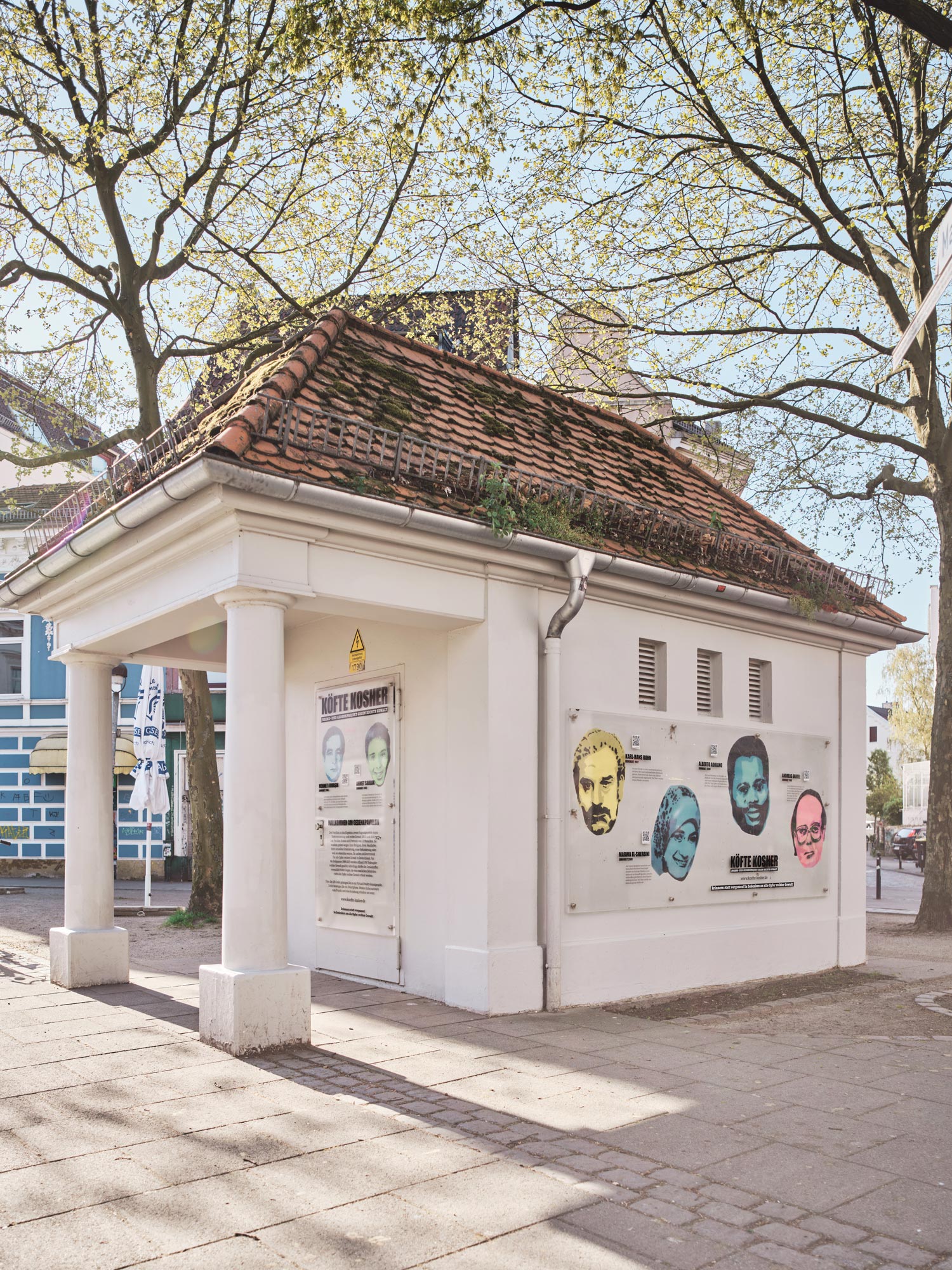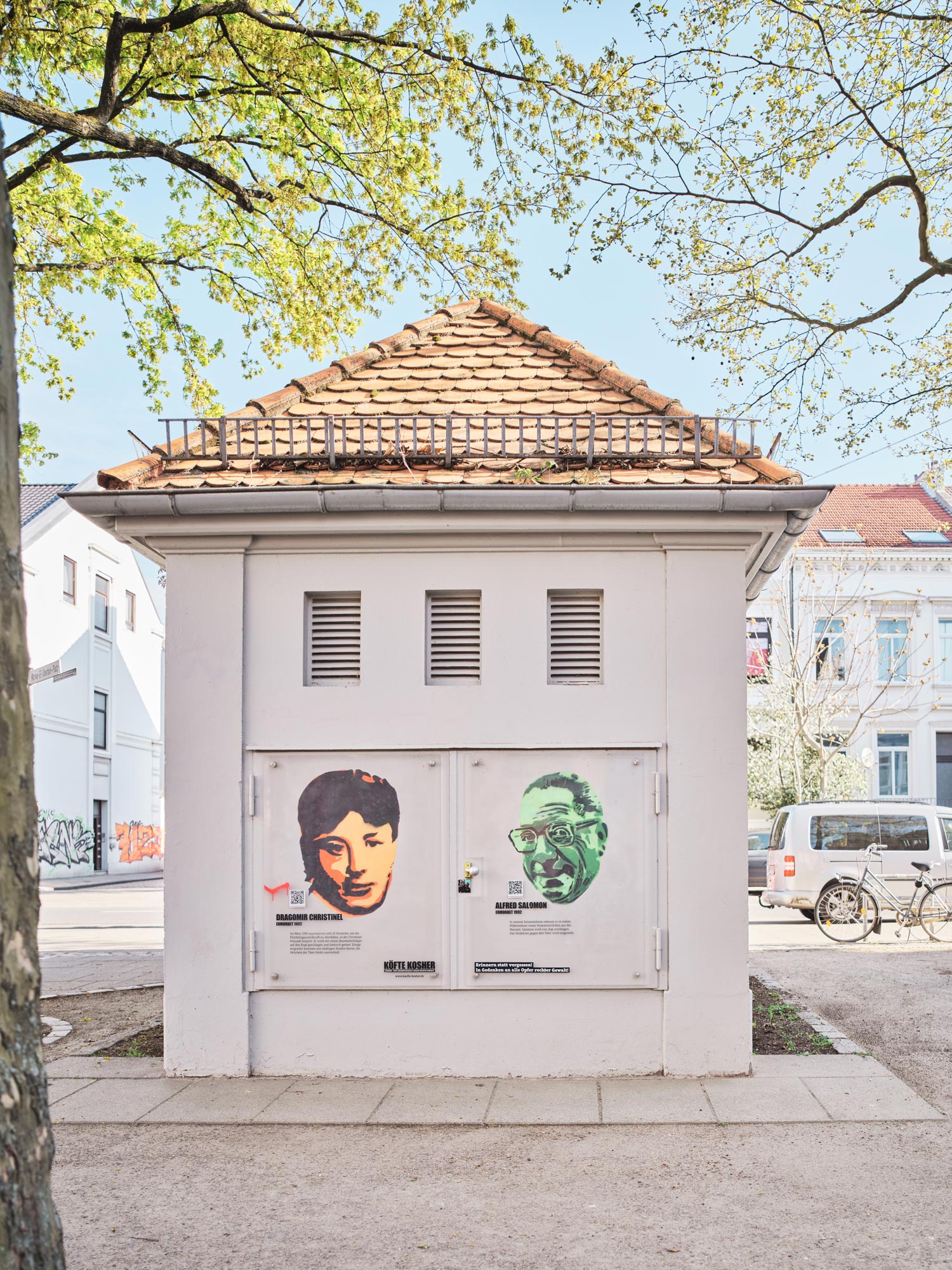Right-wing violence is an unbroken tradition in Germany, part and parcel of the country’s history since the end of World War II. Not a day goes by without children, young people, or adults being discriminated against, humiliated, beaten up, or even murdered. Around 20,000 antisemitic, racist, and other acts of right-wing extremism were committed in Germany from 1990 to 2020. It was to raise awareness of these crimes that Köfte Kosher was launched, an art-activism project with and for young people. Köfte Kosher creates space for young people to talk to each other about their personal experience of discrimination and exclusion on the street and online. Its other major goal is to give people affected by right-wing violence a public platform, where they can be seen, and their voices can be heard. The project also pursues artistic dialogue in public space. This led in 2012 to the Memorial Pavilion in Bremen, with its portraits of victims of right-wing violence. The Pavilion invites people to explore remembrance on site, since 2018 also via VR (virtual reality).
KÖFTE KOSHER Together against Right-Wing Violence!
Lest we forget
-
Ahmet Șarlak
Ahmet Șarlak was born in Sulzbach, Saarland, in 1983, to Turkish immigrants. He was educated at a local school and then began vocational training.
On August 9, 2002, the nineteen-year-old visited a local annual fair with a few friends. They and some men known to be neo-Nazis got into an argument there. One of the neo-Nazis attacked Ahmet Șarlak with a knife, stabbing him several times in the chest and stomach, before running off. The following day, Ahmet Șarlak died as a result of his injuries.
Carlos Neu was not unknown in the Sulzbach Valley area: a few months earlier the police had suspected him of having fired a gas pistol into a cafe mainly frequented by immigrants. When tracking him down, the police found weapons and swastika flags at his home. Also, several witnesses at the fair had clearly identified the neo-Nazi as the offender, and he was arrested.
During the trial, it was completely ignored that the offender was a man with extreme right-wing views who had committed a racially motivated hate crime. Instead, the court classified the case as a brawl among young people and saw “no indication of racist motives.” Carlos Neu was sentenced to six years imprisonment for manslaughter. The judge remarked: “The defendant alone knows what led to his crime.” The family and friends of Ahmet Șarlak protested the verdict. The police ordered them to leave the courtroom.
- Ahmet Sarlak - Amadeu Antonio Stiftung
- Ausstellung Todesopfer Rechter Gewalt
- Aus den Jugenderinnerungen eines Sulzbacher Antifaschisten: Schluss mit der Verharmlosung rechten Terrors!
- 10. August 2016 ANTIFA-Kundgebung in Gedenken an Ahmed Sarlak – am 9.8.2002 von Nazis ermordet | linksunten Archiv
- Rund 350 Menschen demonstrieren am Freitag (24 1 2003) in Sulzbach Sie protestieren gegen das Urtei
- 50 Teilnehmer_innen auf antifaschistischer Kundgebung in Sulzbach
VR (Gedenk)RAUM
Students of the Wilhelm Wagenfeld School have created a virtual dimension for the Memorial Pavilion: VR Commemorative Spaces (that can be experienced with virtual reality glasses).
Students’ discussions are reflected in the range of topics addressed in the VR Commemorative Spaces: from criticism of society and the justice system, to a wish to admonish the visitors, to the students’ own feelings of helplessness in dealing with these terrible events.
By addressing the fate of Ahmet Șarlak, the students hope to have paid him a dignified tribute.

We are standing on an empty church square in Sulzbach, Saarbrücken. This was where the folk festival took place that became the scene of the crime. There is no sign, anywhere, of what happened here on August 9, 2002. As we look around, pulsating lines crowd into the frame. The lines mutate into mottled brownish-grey rectangles. They move to the same rhythm, synchronously shooting up and down. They circle around us and turn into menacing stone columns. Then, all of a sudden, they disappear. The noise ceases. The silence is deafening. It reverberates across the empty church square. Just as if nothing at all had ever happened here.
-
Alberto Adriano
Alberto Adriano was born in Mozambique in 1960. He arrived in the GDR (East Germany) as a contract worker in 1980. He regularly sent a part of his earnings home to his family in Mozambique. In 1990 he met his future wife, Angelika, with whom he settled in Dessau and had three children.
After visiting friends on the evening of June 11, 2000, Alberto Adriano made his way home via a park. There, he came upon three drunken neo-Nazis who derided him with racist remarks, beat him up and, once he was on the ground, repeatedly kicked him in the head. After this onslaught of violence had knocked Alberto Adriano unconscious, the neo-Nazis stripped their helpless victim and flung his clothing around the park. Alerted by the noise, locals called the police and the offenders were arrested. Alberto Adriano never regained consciousness. He died in hospital three days later, as a result of the attack.
Durng the trial, all three offenders confessed their crime without any sign of emotion. They made clear that anyone they see as “different” has, according to their ideology, no right to be alive. The only offender of legal age, Enrico Hilprecht, was given a life sentence. His accomplices, Frank Miethbauer and Christian Richter, both sixteen at the time, were each sentenced to nine years in prison.
VR (Commemorative) Space
Students of the Wilhelm Wagenfeld School have created a virtual dimension for the Memorial Pavilion: VR Commemorative Spaces (that can be experienced with virtual reality glasses).
Students’ discussions are reflected in the range of topics addressed in the VR Commemorative Spaces: from criticism of society and the justice system, to a wish to admonish the visitors, to the students’ own feelings of helplessness in dealing with these terrible events.
By addressing the fate of Alberto Adriano, the students hope to have paid him a dignified tribute.
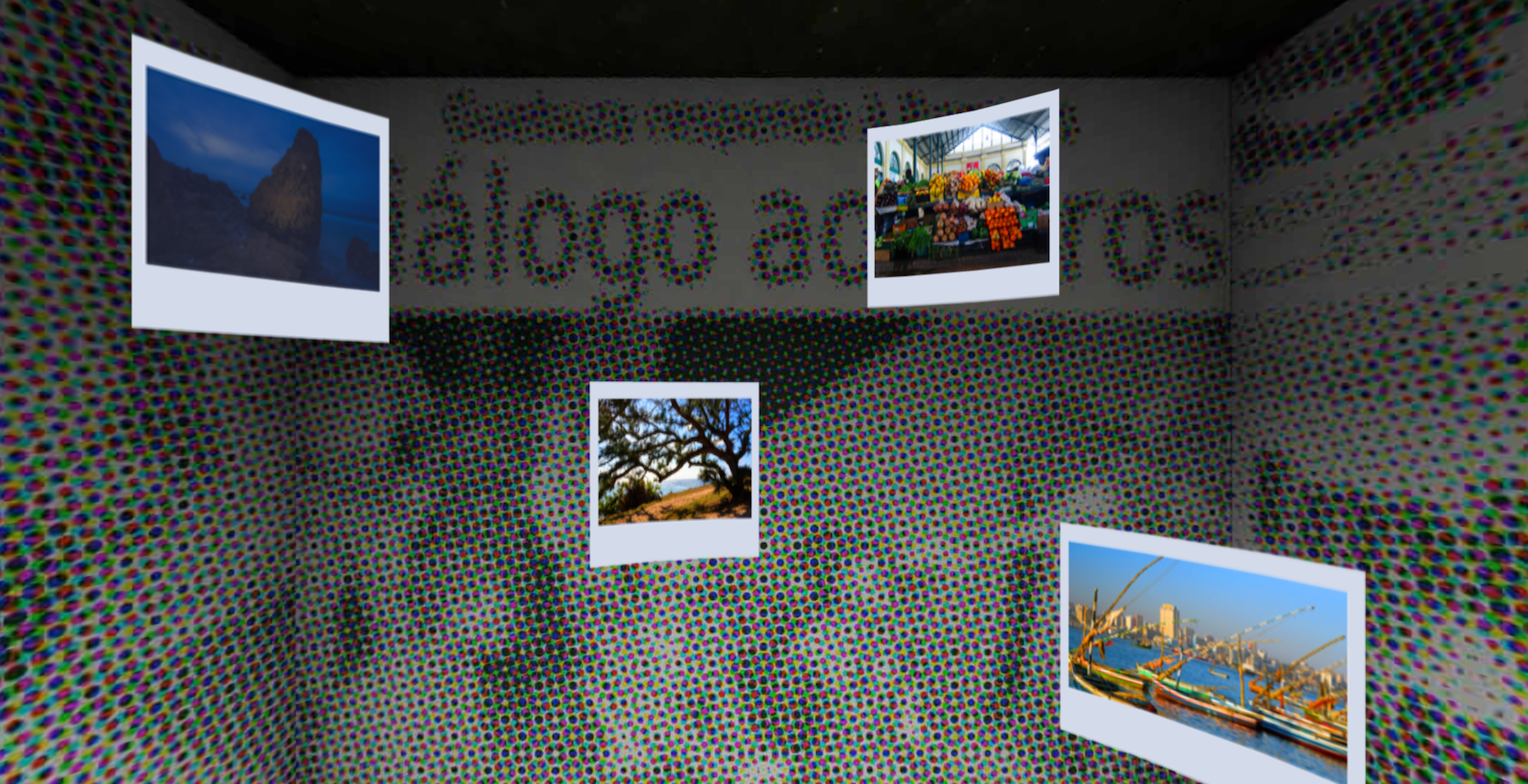
We are standing before the memorial stone set up for Alberto Adriano in the city park in Dessau. A slow fade transports us to a new space composed of two superimposed visual frames. In the foreground, white-framed photographs float in a circular motion. The images are in various formats but the moment they reach eye level, they take on the dimensions of a Polaroid photo. The constant movement and the visual shifts make us feel we are standing within a mobile. The photographs look like vacation snapshots. In the background is a wall of extremely enlarged and indistinct pixels. On closer inspection, we can see the pixel wall is composed of newspapers whose content, however, remains blurred and illegible. Here, current affairs dissolve into pixels. The newspapers and the photographs are from Mozambique. Alberto Adriano worked as a contract worker in the GDR (East Germany). Shortly before he was murdered, he had been planning to return to Mozambique, departing July 3, 2000. The father of three had saved up for four years to be able to visit his family living there. But it was not to be.
-
Françoise Makodila Landu
Françoise Makodila Landu was born in Congo in 1964. From there, she fled to Germany with her husband, Jean-Daniel Makodila, and their five children: Jean-Daniel (aged 3), Legrand (5), Christelle (8), Miya (14), and Christine (17). The family was housed in a refugee shelter on Hafenstraße [street] in the city of Lübeck.
In the night of January 17–18, 1996, the refugee shelter was set on fire. Françoise Makodila Landu made a desperate call to the police at around 3 a.m. But help came too late to save her. She died in the burning building, along with her five children and four other people. Her husband was not in Lübeck at the time. Many other residents were injured in the fire.
The night of the attack, the police arrested four far-right skinheads directly at the scene. Despite burn marks on their hair and their contradictory statements, they were released without charge. Even a confession filed two years later in the district attorney’s office was not taken seriously. On the contrary, the inquiries focused mainly on a twenty-one-year-old resident of the shelter from Lebanon, who was accused of setting fire to the building after an argument. The district court of Kiel dismissed the charges against him in autumn 1999. Yet it also rejected an appeal to re-open the case against the neo-Nazi skinheads.
VR (Commemorative) Space
Students of the Wilhelm Wagenfeld School have created a virtual dimension for the Memorial Pavilion: VR Commemorative Spaces (that can be experienced with virtual reality glasses).
Students’ discussions are reflected in the range of topics addressed in the VR Commemorative Spaces: from criticism of society and the justice system, to a wish to admonish the visitors, to the students’ own feelings of helplessness in dealing with these terrible events.
By addressing the fate of Françoise Makodila Landu, the students hope to have paid her a dignified tribute.
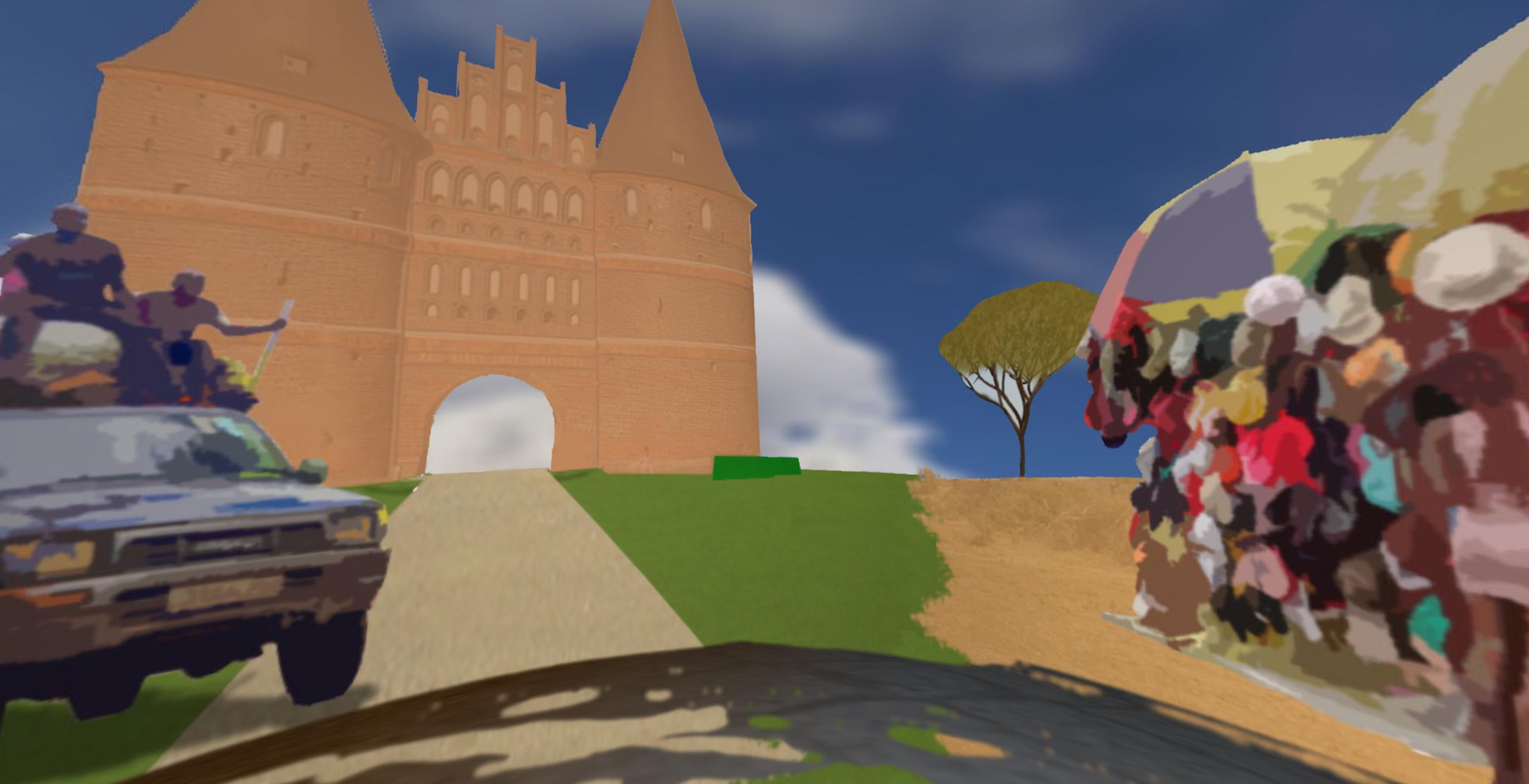
We are at Hafenstrasse 52, in the industrial area of the city of Lübeck. There used to be a house at this address, a shelter for refugees. Now, instead, there is a memorial stone. At the foot of the stone is a memorial wreath, covered by snow. It is a dead place, a grim place. The snow is freshly fallen.
Then a new space opens up and we find ourselves moving within a colorful collage of diverse images and illustrations. We see places, people, and vehicles—evidently, scenes from an everyday life. At a closer look, it becomes clear that localities are overlapping, brought face to face before merging into one another. A passenger ship, doubtless a symbol of the port city of Lübeck, exists under the same sky as the market stall from Kinshasa. Here, the different places where Françoise Makodila Landu once lived come together.
-
Marwa El-Sherbini
Marwa El-Sherbini was born in Egypt on October 7, 1977. She worked as a pharmacist and for a time played successfully in Egypt’s national handball team. In 2005 she travelled to Bremen to join her husband, Elwy Ali Okaz, who had moved there to do a Master’s (MSc) in Molecular Biology. Soon afterwards their son, Mustafa, was born. For professional reasons, the family then moved to Dresden, where Marwa El-Sherbini worked as a pharmacist.
In 2008, when Marwa El-Sherbini was at a playground with her son, she was insulted by a far-right extremist as an “Islamist,” a “terrorist,” and a “slut.” Without hesitation, she reported him to the police. The offender, Alex Wiens, aged twenty-eight at the time, was sentenced to a fine. He appealed against the sentence. A lawsuit followed, to which Marwa El-Sherbini was summoned as a witness.
She was pregnant with her second child at the time, and attended the court with her husband and son. During the trial, Wiens repeatedly made derogatory racist remarks. When Marwa El-Sherbini was about to leave the courtroom after giving testimony, Wiens attacked her and killed her with eighteen stab wounds. Her husband, who rushed to her aid, was critically wounded with three knife wounds—all this in full view of their three-year-old son.
In 2009 Alex Wiens was convicted to life imprisonment for murder and attempted murder. The district attorney’s office stated that the crime was motivated by “extreme racism.” Marwa El-Sherbini’s mortal remains were returned to her family in Egypt and buried there the following day. Her murder prompted international outrage.
VR (Commemorative) Space
Students of the Wilhelm Wagenfeld School have created a virtual dimension for the Memorial Pavilion: VR Commemorative Spaces (that can be experienced with virtual reality glasses).
Students’ discussions are reflected in the range of topics addressed in the VR Commemorative Spaces: from criticism of society and the justice system, to a wish to admonish the visitors, to the students’ own feelings of helplessness in dealing with these terrible events.
By addressing the fate of Marwa El-Sherbini, the students hope to have paid her a dignified tribute.

We are standing in the empty courtroom of the Dresden District Court, where Marwa El-Sherbini was murdered. As we look around, the room starts falling to pieces, bit by bit, until the courtroom as such no longer exists. Once the courtroom has disintegrated, faith in justice and hope for justice completely evaporate too. Lady Justice or Justitia, who personifies the rule of law, likewise falls apart. Will anyone ever get over the shock of seeing that a primary witness, a victim of racial harassment, can be murdered by the defendant in the middle of a trial?
-
Belaid Baylal
Belaid Baylal was born in Morocco in 1958. He campaigned in his country for better working conditions. Participation in a strike in 1980 led to his arrest and torture. After his release, he fled to Germany via Libya and Algeria. He applied for asylum here in 1991.
On May 8, 1993, he and four friends went to a restaurant in the town of Belzig, where Baylal lived at the time in a refugee shelter. Later that evening, two teenagers entered the restaurant and loudly declared: “We don’t like foreigners.” They began to insult the small group and bombard it with bottles. Three of the group then left. Belaid Baylal and a friend stayed. Shortly afterwards, the neo-Nazis attacked the two of them. They knocked Belaid Baylal to the ground, beat him, and repeatedly kicked him in the stomach.
Belaid Baylal was taken to hospital with serious internal injuries. The attack had permanently damaged his health and he was discharged only several weeks later. For Belaid Baylal, the next seven years were marked by reclusion, illness, and pain. Then on November 3, 2000, at the age of only forty-two, he died owing to the injuries inflicted on him.
In court, his attackers baldly stated: “Foreigners should not go to German restaurants.” The offenders were sentenced to probation and fines.
VR (Commemorative) Space
Students of the Wilhelm Wagenfeld School have created a virtual dimension for the Memorial Pavilion: VR Commemorative Spaces (that can be experienced with virtual reality glasses).
Students’ discussions are reflected in the range of topics addressed in the VR Commemorative Spaces: from criticism of society and the justice system, to a wish to admonish the visitors, to the students’ own feelings of helplessness in dealing with these terrible events.
By addressing the fate of Belaid Baylal, the students hope to have paid him a dignified tribute.

We are standing by the memorial stone erected in the town of Belzig on November 4, 2004, to commemorate Belaid Baylal. We have around thirty seconds to look around, before a new space engulfs us. Now we are on the back seat of a moving car, with cityscapes rushing by. High in the sky above the rooftops fly doves of peace. They symbolize the trade unionist Belaid Belayl, who worked all his life long for a better life for everyone. The car journey leads from Morocco via Tunisia to Germany. But in Germany, the outlook changes. In German airspace, there are no more doves of peace. Suddenly, the light fades away. Everything goes black. The city disappears from view. It is unclear, whether we are still in the moving car or have arrived. We stand in the dark, all alone.
-
Karl-Hans Rohn
Karl-Hans Rohn was born in 1939. Unfortunately, the exact date and place of birth could not be verified. He lived in Wuppertal as a single man and worked as a butcher, until he was made redundant.
In the night of November 12–13, 1992, Karl-Hans Rohn went to a pub in the Unterbarmen district of Wuppertal, and took a seat at the bar alongside two men who were members of the meanwhile illegal far-right organization “Nationalistische Front” (Nationalist Front). The three men were the only guests. The owner of the bar had a grudge against Karl-Hans Rohn, who had not yet settled his tab from a previous visit. In the belief that Karl-Hans Rohn was Jewish, the owner began to stir up trouble among the men. Soon, the two neo-Nazis began beating up Karl-Hans Rohn and kicked him to the floor. They poured alcohol over him and set him alight. Since the smoke got too much for them, the three offenders put out the fire before it killed Karl-Hans Rohn, yet by this time it was clear there was no saving him. They packed him into a car and carted him to the Dutch border, where he was found dead the next day, in a ditch.
Traced thanks to their tire tracks, the offenders were sentenced for murder to prison terms of between eight and fourteen years. The court found that: “The offenders [were] so saturated with far-right extremism that their actions at a decisive moment followed a radical neo-Nazi pattern.” The murder of Karl-Hans Rohn made the headlines in the international press.
VR (Commemorative) Space
Students of the Wilhelm Wagenfeld School have created a virtual dimension for the Memorial Pavilion: VR Commemorative Spaces (that can be experienced with virtual reality glasses).
Students’ discussions are reflected in the range of topics addressed in the VR Commemorative Spaces: from criticism of society and the justice system, to a wish to admonish the visitors, to the students’ own feelings of helplessness in dealing with these terrible events.
By addressing the fate of Karl-Hans Rohn, the students hope to have paid him a dignified tribute.

We are on a street. On the facade of the house to our right, above a white door frame, we see the number 31. Above it, a bare oblong patch betrays that a sign once hung there. We can assume that this door was once the main entrance to “Laternchen’s,” the Wuppertal pub that Karl-Hans Rohn visited on November 12, 1992. His visit to the pub proved fatal—yet there is no sign of a memorial plaque or anything else on the facade or on the street. Only the ghostly shadow of the pub sign no longer above the entrance admonishingly hovers above our heads, as a silent witness. Then a new space opens up. Single black strokes shoot from different directions across the white background. An irregular network emerges, composed of fifty-three strokes. It is an asymmetrical pattern, which breaks off abruptly, still incomplete. Karl-Hans Rohn was fifty-three years old when he was murdered.
-
Helmut Sackers
Helmut Sackers was born in Kleve (North Rhine-Westphalia) on April 20, 1940. He worked as a long-distance truck driver and later moved to Halberstadt in Saxony-Anhalt. Acquaintances describe him as a man who always openly voiced his opinions and firmly believed in tolerance and democracy.
On April 29, 2000, Helmut Sackers was at home having coffee with his partner, when they were disturbed by loud music. Helmut Sackers immediately grabbed his phone to alert the police: a neighbor was clearly playing extremist far-right songs, which is against the law in Germany.
When the officers arrived, they asked the young man to turn down his music. Its content was of no concern to them—they drove off. One hour later, in the lobby of the building, the neighbor stabbed sixty-year-old Helmut Sackers to death. After arresting the neighbor, the police searched his apartment and found there CDs, videos, and printed matter that were incontrovertible proof of his links with the radical neo-Nazi scene.
Despite this evidence, the crime was treated as a conflict between neighbors over too loud music. There were two trials, at which the court gave credence to the defendant, although neither the progression of events nor the witness statements were unambiguously portrayed. In the end, the defendant was found not guilty. The verdict prompted outrage nationwide. To this day, Helmut Sackers’ partner continues to fight for justice and proper commemoration of her murdered lover. He is not officially classified as a victim of far-right violence.
VR (Commemorative) Space
Students of the Wilhelm Wagenfeld School have created a virtual dimension for the Memorial Pavilion: VR Commemorative Spaces (that can be experienced with virtual reality glasses).
Students’ discussions are reflected in the range of topics addressed in the VR Commemorative Spaces: from criticism of society and the justice system, to a wish to admonish the visitors, to the students’ own feelings of helplessness in dealing with these terrible events.
By addressing the fate of Helmut Sackers, the students hope to have paid him a dignified tribute.
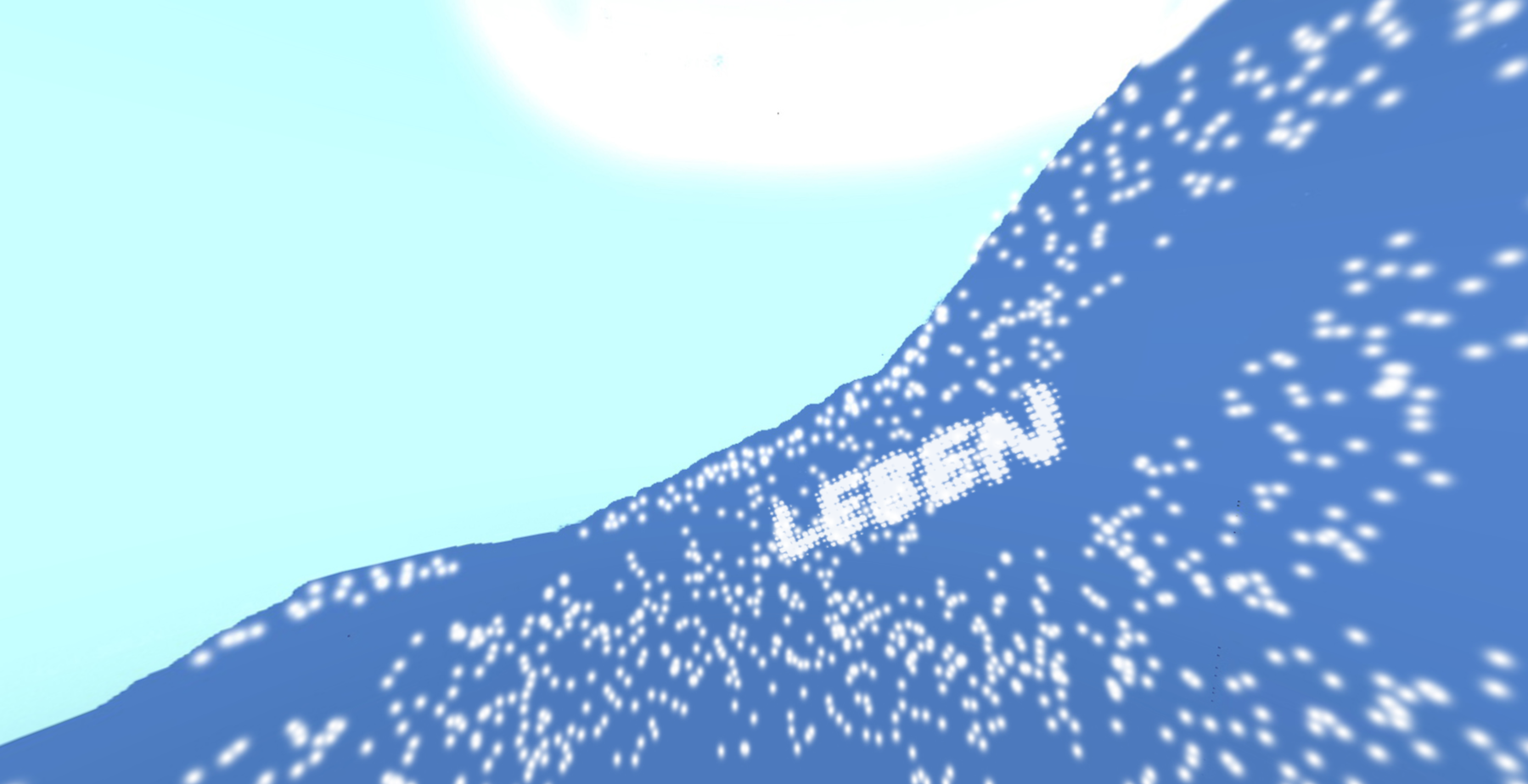
A stairwell in an apartment building. The doors and the elevator are closed. Then we are in a new room. The perspective changes: we see an illustrated aerial view. We are looking down at many small lights, some of them in clusters, others not. They could be landscapes with invisible borders; various inhabited places, where the streets and houses are brightly lit. Now, terms such as “friendship,” “honesty,” “tolerance,” “love,” “life,” and “civil courage” appear, written in lights. They remind us of the neon or LED signs we know from advertising, except that the “product” in this case is “human compassion.” Periodically, the entire image morphs into a vibrating wave. Strength lies in coming together as a movement, and in the courage to act together in solidarity.
-
Dragomir Christinel
Dragomir Christinel was born in 1974 in Romania. He sought asylum in Germany under unknown circumstances. Not much is known about his life until March 15, 1992. That evening, the eighteen-year-old visited friends at a refugee shelter in Saal, near Rostock.
The previous evening, Romanian youths had been thrown out of a nearby disco after other guests had “complained” about them. Outside the disco, a group of young German locals had threatened two Romanians and also blocked their escape route. One Romanian had therefore used a knife, injuring an attacker in the hip. The Romanians were then followed back to the refugee shelter and told they should reckon with revenge.
The next day, around twenty-five people gathered. They organized a few cars, in which later a gas pistol and a fire extinguisher were found. The group set off to the refugee shelter with the intention of attacking it. Dragomir Christinel was one of the first to fall victim to the violence. He was killed by blows to the head with a blunt object (a baseball bat, according to the press).
In June 1992, the district court of Rostock sentenced an eighteen-year-old juvenile offender to two and a half years in prison—for grievous bodily harm resulting in death, as well as for a serious breach of the peace. Two other offenders were put on probation. The rest of the culprits were not traced.
VR (Commemorative) Space
Students of the Wilhelm Wagenfeld School have created a virtual dimension for the Memorial Pavilion: VR Commemorative Spaces (that can be experienced with virtual reality glasses).
Students’ discussions are reflected in the range of topics addressed in the VR Commemorative Spaces: from criticism of society and the justice system, to a wish to admonish the visitors, to the students’ own feelings of helplessness in dealing with these terrible events.
By addressing the fate of Dragomir Christinel, the students hope to have paid him a dignified tribute.

We are standing in a sanitary facility that is equipped for several people. Everything about it suggests that this is a makeshift solution: temporary housing for visitors. That someone or other’s laundry is hung out to dry is the only sign that the space is in use. Suddenly, the image shifts and we find ourselves in a new space. In front of us, there is a graphic image comprised of colorful waves on a black background, with heartbeats on it, too. The waves resemble an electrocardiogram, the difference, here, being that no heart rhythms are being measured. Several pulsating heartbeats flow in opposite directions, one above the other. The curves continue beating and rising, finally describing circles. We are in the middle of the action. Until everything stops. The heartbeats symbolize Dragomir Christinel’s life, tragically cut short.
-
Mehmet Kubaşık
Mehmet Kubaşık was born in Turkey on May 1, 1966. He worked on his father’s farm. Against his parents’ wishes he married his first love, Elif. In 1986, their daughter, Gamze, was born. In 1991, to escape their political persecution as Kurdish Alevis, the young family sought refuge in Germany. For the two years until their asylum application was approved, the Kubaşıks lived in a refugee shelter. Two sons were born. In 2003, all the family acquired German citizenship. Until he suffered a stroke, Mehmet Kubaşık worked as a handyman and construction worker. Finally, he opted for self-employment, opening a kiosk in Dortmund. His whole family helped out there.
At midday on April 4, 2006, Mehmet Kubaşık was found dead, gunned down behind the counter of his kiosk. The police initially put the crime down to a family feud with someone known to the victim. When this charge proved unfounded, the police began investigating Kurdish organizations. The Kubaşık family and their immediate circle remained under suspicion for years. That the murder was a case of far-right terrorism was not considered until November 2011, when far-right terrorist network National Socialist Underground (NSU) was exposed. The NSU is responsible for numerous attacks and robberies, as well as nine racist murders. Mehmet Kubaşık was the eighth victim of the NSU’s serial killing spree.
Five people were convicted in the criminal proceedings against the NSU. Yet there are numerous indications that many others (including state employees) were involved, as well as an extensive network of supporters. To this day, the NSU affair has not been definitively solved.
- Mehmet Kubaşık – Wikipedia
- https://www.ruhrnachrichten.de/dortmund/vor-14-jahren-wurde-mehmet-kuba%C5%9F%C4%B1k-in-dortmund-vom-nsu-ermordet-1510444.html
- Tochter von NSU-Opfer: "Kein Schlussstrich unter das Thema"
- NSU: Am 15. Todestag von Mehmet Kubaşık ruft das Bündnis „Tag der Solidarität“ zum individuellen Gedenken auf - Nordstadtblogger
- NSU-Prozess: Interview mit Gamze Kubaşık am 10.07.18 - YouTube
- Eine Tochter will Gerechtigkeit | Deutschland | DW | 25.04.2013
VR (Commemorative) Space
Students of the Wilhelm Wagenfeld School have created a virtual dimension for the Memorial Pavilion: VR Commemorative Spaces (that can be experienced with virtual reality glasses).
Students’ discussions are reflected in the range of topics addressed in the VR Commemorative Spaces: from criticism of society and the justice system, to a wish to admonish the visitors, to the students’ own feelings of helplessness in dealing with these terrible events.
By addressing the fate of Mehmet Kubaşık, the students hope to have paid him[jd1] a dignified tribute.
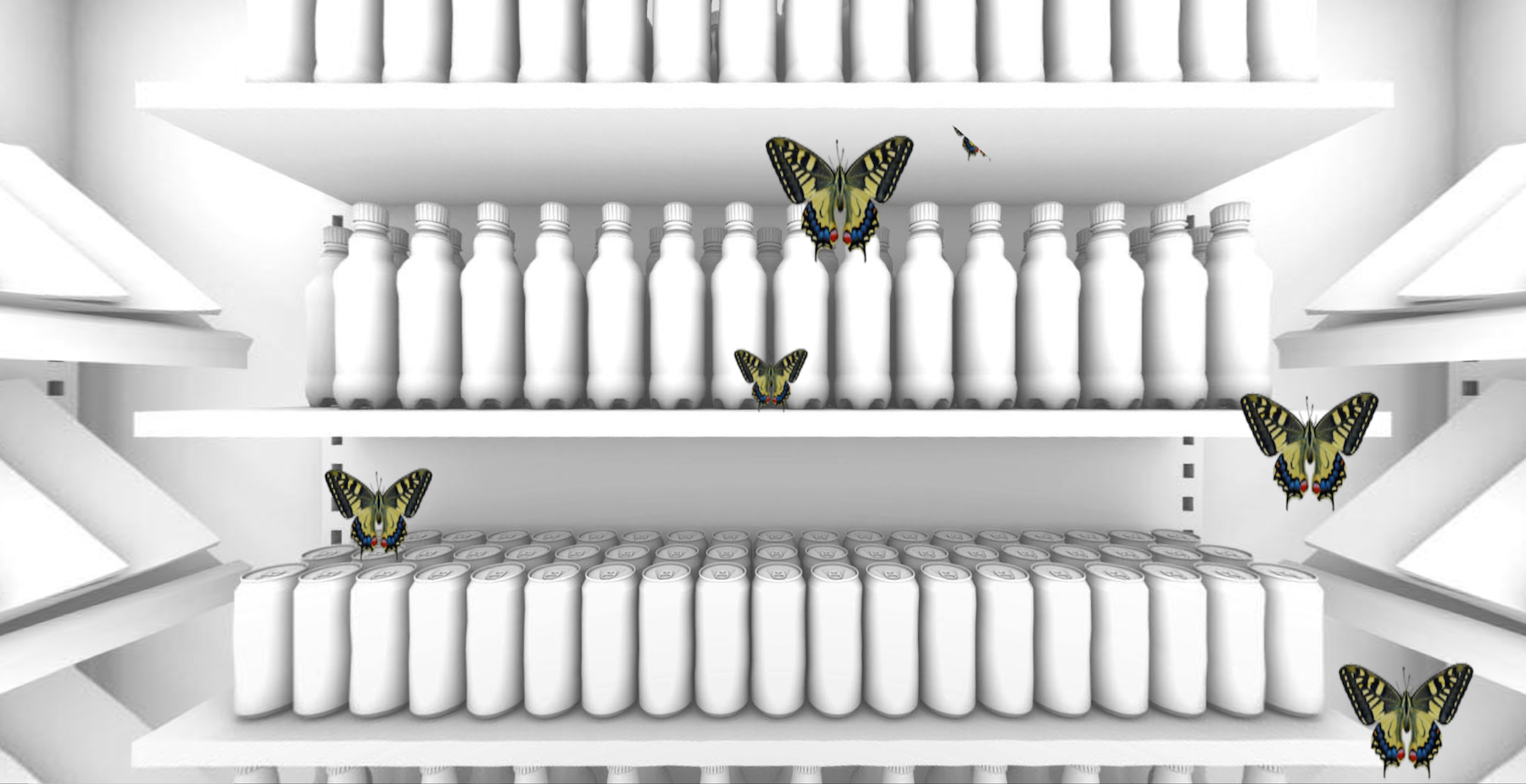
We are standing on Mallinckrodtstraße (street) in Dortmund, in front of the memorial plaque for Mehmet Kubaşık. After a while, the street disappears behind fragmented images. A new space, a new image emerges. We are in a kiosk now, among shelves stacked high, although the kiosk appears to be empty. All the products are in plain white packaging, but their various shapes seem familiar and comforting. On the other hand, the absence of the bright colors and labels we are used to makes us sense that something is missing. Suddenly, colorful butterflies fly off the shelves. And for a fleeting moment, the kiosk that was at the heart of Mehmet Kubaşık’s daily life comes back to life.
-
Klaus-Peter Beer
Klaus-Peter Beer was born in 1947 in Amberg (Bavaria), a small town with 30,000 inhabitants. He felt unable to live there openly as a gay man, so decided at the age of nineteen to try his luck in a larger place. He moved first to Darmstadt and then later to Frankfurt am Main, where he drove buses and taxis for a living.
Klaus-Peter Beer regularly returned to Amberg to visit his parents. September 1995 was one such occasion. His parents were sick at the time. On September 7, he met two young men in a bar, got into conversation, and unsuspectingly followed them outside. Beer had no idea that he had run into two extremely dangerous neo-Nazis. Richard Lorenz and Dieter Müller had earlier announced at a skinhead event that they intended to kill a gay man. In a park, they brutally beat up Klaus-Peter Beer, before finally throwing him, unconscious, into a river. He drowned.
Richard Lorenz and Dieter Müller later boasted of their deed at various radical far-right events. Three years passed before the offenders were sentenced for murder to prison terms of between eight and twelve years. In court, each said they had wanted “to teach the victim a lesson.” The investigating authority no longer rules out their possible connection with the far-right terrorist network National Socialist Underground (NSU) The commemoration of Klaus-Peter Beer has long remained a contentious issue in Amberg. Memorial plaques have been unlawfully removed and years went by before a town official attended a memorial event.
- https://www.br.de/nachrichten/bayern/1995-ermordet-mann-nun-offiziell-opfer-rechter-gewalt,STz3lbJ
- Klaus Peter Beer | Oberpfalz TV
- Gedenken an Amberger Neonazi-Opfer Klaus Peter Beer | Endstation Rechts. Bayern
- Das Leben des Klaus-Peter Beer - IMDb
- https://opfer-rechter-gewalt.de/wp-content/uploads/2018/04/track3.mp3
VR (Commemorative) Space
Students of the Wilhelm Wagenfeld School have created a virtual dimension for the Memorial Pavilion: VR Commemorative Spaces (that can be experienced with virtual reality glasses).
Students’ discussions are reflected in the range of topics addressed in the VR Commemorative Spaces: from criticism of society and the justice system, to a wish to admonish the visitors, to the students’ own feelings of helplessness in dealing with these terrible events.
By addressing the fate of Klaus-Peter Behr, the students hope to have paid him a dignified tribute.
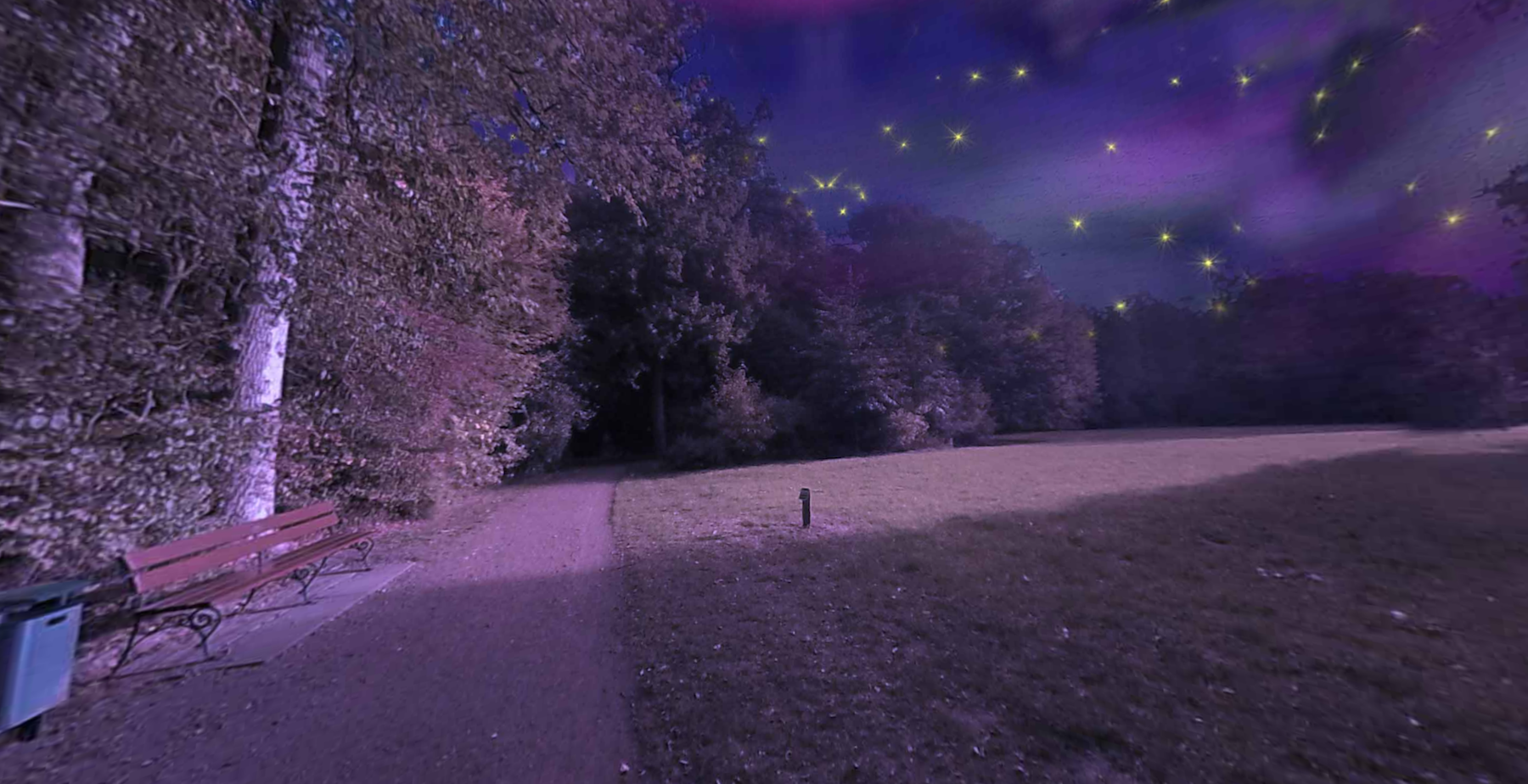
We are in a restaurant. Then a new space opens up: a city park in the middle of the night, illuminated by stars. The extreme colors create a sense of irritation. Everything seems remote, although we are right in the thick of it. A clearing can be seen. It seems like a sideshow. Opposite, stands an empty wooden bench that seems lost. The mood sparks uneasiness, despite the colors. There are many stars and some are shining together, in twos and threes. They become a part of the silence and create a place of absence with their luminosity.
-
Andreas Oertel
Andreas Oertel was born in 1963 and grew up in Halle an der Saale in former East Germany. Due to the early death of his parents, he lived for a long time in a home, but at the age of thirty-four, he was finally able to move into his own apartment. For over ten years Andreas Oertel worked in a carpentry workshop.
People who knew him describe him as friendly, reserved, and also a bit gullible. His passion was the theater. He tried never to miss a performance at the New Theater in Halle. Many members of the ensemble valued him as a faithful companion and critic. Andreas Oertel lived openly as a homosexuel.
On March 21, 2003, a group of far-right extremists invaded Andreas Oertel’s home and accused him of child molestation. Over the next two days, they and a number of other people turned up repeatedly at his home to abuse and rob him. Andreas Oertel died as a result of the massive physical injuries inflicted on him.
After boasting publicly about their “disciplinary action,” the offenders were arrested. In court, they said they had wanted, among other things, to punish Andreas Oertel for being gay. They were found guilty of aggravated robbery resulting in death and of grievous bodily harm, and were sentenced to prison terms of varying duration.
VR (Commemorative) Space
Students of the Wilhelm Wagenfeld School have created a virtual dimension for the Memorial Pavilion: VR Commemorative Spaces (that can be experienced with virtual reality glasses).
Students’ discussions are reflected in the range of topics addressed in the VR Commemorative Spaces: from criticism of society and the justice system, to a wish to admonish the visitors, to the students’ own feelings of helplessness in dealing with these terrible events.
By addressing the fate of Andreas Oertel, the students hope to have paid him a dignified tribute.
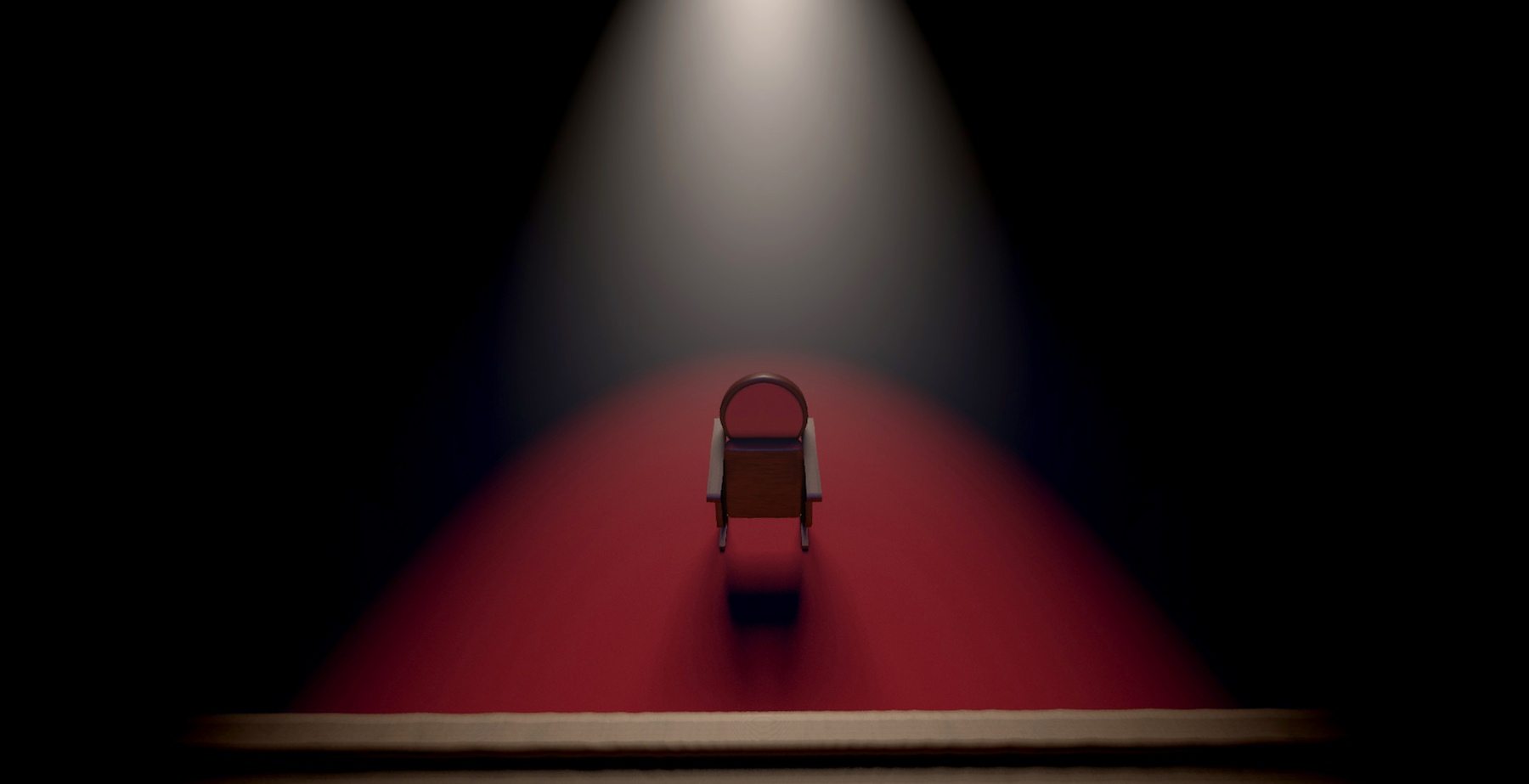
We are in a rundown stairwell. A staircase in front of us leads to a closed, red stage curtain. What may be hidden behind it is anyone’s guess. After a while, a spotlight falls onto the red curtain. The light grows more glaring and intense while the shadows around the staircase darken. Suddenly, the scenery changes. Now, we are on stage, blinded by the spotlight pointed in our direction. There is an empty chair in front of us. A closer look reveals that the spotlight is not on us, but on the chair. We, the viewers, are now on stage, in place of the actors. The empty chair in the spotlight highlights that Andreas Oertel is no longer with us.
-
Alfred Salomon
Alfred Salomon was born in Berlin in 1900. As a young man he lived and worked in Cologne, joined a trade union and, later, also the Socialist Party of Germany (SPD). In Cologne he met Katharina “Käthi” Lambertz. The couple married and had four children. They lived in an area that the people of Cologne used to call Little Moscow, because the locals there were avid supporters of the Communist Party of Germany (KPD).
Two days before the Nazis seized power in the general elections of 1933, violent clashes broke out between residents of the neighborhood and the Nazi’s first paramilitary, the Sturmabteilung (SA). Although Alfred Salomon had not taken part in the rampage, he was arrested that same night. Like many of his neighbors, he came under “general suspicion” and was interrogated and beaten. He was released only several days later.
According to the Nazis’ Nuremberg Laws, which came into force in 1935, Alfred Salomon was a “Jewish half-breed” (Halbjude). During the November pogroms of 1938, his father was beaten up in front of him by the SA, and later deported; he died in 1943 under unexplained circumstances. Alfred Salomon was likewise carted off and condemned to forced labor by the Nazis. At the Dachs IV concentration camp in Osterode he had to do twelve hours of exhausting physical labor every single day. Any weakness was punished with kicks and blows. After the war, Alfred Salomon learned that his wife Käthi and three of his children had been killed in a bombing raid.
By the age of ninety-two, he was living in a retirement home in Wülfrath. His fellow residents repeatedly harassed him with anti-Semitic abuse. Alfred Salomon complained to the home managers, but nothing was done. He then ran into Johann Krohn at the home, formerly SS Oberführer (brigadier) at the head of Organization Todt, the civil and military engineering unit for which Alfred Salomon had had to do years of forced labor. The two men got into an argument, whereupon the eighty-nine-year-old Johann Krohn beat Alfred Salomon so violently as to cause him to die shortly afterwards.
Inquiries into the case against Johann Krohn were quickly dropped, without him ever being asked about his past.
- Alfred Salomon - Amadeu Antonio Stiftung
- (20) Opferperspektive e.V. auf Twitter: „Am 21. November 1992 stirbt Alfred Salomon nach den Schlägen eines Altnazis an einem Herzinfarkt in einem Altenheim in Wülfrath (Nordrhein-Westfalen). Der Holocaustüberlebende war zuvor immer wieder antisemitisch beschimpft worden. #Antisemitismus #rechteGewalt https://t.co/mIEgWKPbjt“ / Twitter
- Weitere Tötungsdelikte mit zu vermutender oder tatsächlicher rechtsextremer oder ausländerfeindlicher Motivation aus dem Jahr 1992
VR (Commemorative) Space
Students of the Wilhelm Wagenfeld School have created a virtual dimension for the Memorial Pavilion: VR Commemorative Spaces (that can be experienced with virtual reality glasses).
Students’ discussions are reflected in the range of topics addressed in the VR Commemorative Spaces: from criticism of society and the justice system, to a wish to admonish the visitors, to the students’ own feelings of helplessness in dealing with these terrible events.
By addressing the fate of Alfred Salomon, the students hope to have paid him a dignified tribute.

We are in a room full of tables and chairs, a sign that people regularly meet here to eat—although, at the moment, there is no one in this place of encounter. A new room opens. We can see a white grand piano, with plants growing out of it. Alfred Salomon, a Shoah survivor, was a music lover. The piano was his passion. Music helped him immerse himself in a world of melodies and briefly forget his sad memories. The plants symbolize sounds that flourish within the piano and emerge from it as symbols of the cycle of nature: blossoming, surviving, and continuing to grow.
Right-wing violence in Germany is not an isolated incident.
Right-wing violence in Germany is systemic.
Right-wing violence kills.
At least 214 people were killed by right-wing violence in the years 1990 to 2021, reports the Amadeu Antonio Foundation in Berlin. Some of these murders shocked society but others were barely even noticed. Most of the victims have been forgotten; neither their name nor a photograph of them was ever published. The Köfte Kosher project therefore chose to put the stories of twelve victims of right-wing violence back in the public eye—so that they would never be forgotten.
By drawing on a long-term research project of the newspapers Tagesspiegel and Die Zeit, an exhibition about victims of right-wing violence, “Opfer rechter Gewalt” (Ohne Titel | TODESOPFER RECHTER GEWALT SEIT 1990), and research by the Amadeu Antonio Foundation (Todesopfer rechter Gewalt), we were able to produce short texts, street art, and VR (virtual reality) memorials dedicated to twelve individuals.
Marwa-El-Sherbini-Platz
The Memorial Pavilion on Marwa-El-Sherbini-Platz in the Steintor district of Bremen is an art project produced by young people to tackle discrimination and right-wing violence. It commemorates twelve victims of right-wing violence—individuals who were murdered simply because their killer thought they had no right to live, because of their religion, their skin color, their sexual orientation, their other-abledness (disability), or their homelessness. These twelve people stand symbolically for all victims of right-wing violence in Germany.
Since launching the Köfte Kosher project in 2012, our primary concern has been to raise public awareness of victims of right-wing violence. In 2018, we did so by finally renaming the square in Bremen, where our Memorial Pavilion stands. Marwa-El-Sherbini-Platz is now the official name. Marwa El-Sherbini is one of the victims of violence whose tragic fate is commemorated on our Memorial Pavilion. She lived in Bremen from 2005 to 2008.
The Yortsayt Memorial Event for Marwa El-Sherbini is held on the square every July 1.
